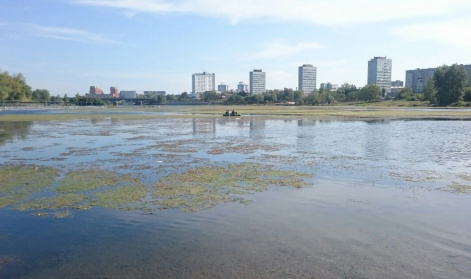Water in the Abakan channel blooms primarily due to low flow velocity
8 December 2020 г.

Algae Bloom in water systems is one of the environmental problems typical of many rivers and lakes. It is associated with the uncontrolled reproduction of various types of algae. The plant biomass overgrown in the water floats to the surface, starts to rot, affects the quality of water and sometimes makes the reservoir unsuitable for human recreation, or for the life of fish and other inhabitants.
A lot of Krasnoyarsk citizens are well familiar with this problem. In the center of the city, between the island and the right bank, there is the Abakan channel, which has been blooming in recent years. The upper reaches of the channel is blocked by a dam, where the heated water of the thermal power plant is discharged, with a fish farm being also located there. Each of these factors, or all of them together, can be the cause of the channel algae bloom.
Scientists of the Federal Research Center "KSC SB RAS" and Siberian Federal University measured for two years the quality and velocity of the water flow, took samples of water and living organisms in different parts of the Abakan channel to estimate the role of various effects on its bloom. As a result, the scientists named the decrease in the flow velocity as the main reason, which leads to the fact that the ecosystem of the river changes and becomes closer in its properties to the lake ecosystem.
Scientists chose several sites for regular observations. The first was located in front of the dam which constraints the water flow of the channel. The others were chosen to be in the water channel: one at a short distance from the dam and two others downstream, in the area where the heated water of the thermal power plant are discharged and down from the fish ponds near the city beach. With this approach, the first site can be used for comparison with the others as the control undisturbed section of the river. The measurements of the velocities of the currents in the channel show that the water there does not move like in the river downstream. In the channel, there are slow movements of water in all directions, which is more typical of a lake or water reservoir. As a consequence, the species composition of organisms also changes. In the water there appear crustaceans and algae, typical of lakes, which start reproducing more intensively with an increase in the temperature of standing water.
“We see that the restructuring of the living community of the Abakan channel occurs due to a decrease in its flow velocity due to the low capacity of the drainage pipes located in the dam. It is just downstream the dam that the main changes in the biomass and species composition of aquatic plants and crustaceans are observed. At the downstream stations, it is an increase in temperature and biogenic load that contributes to a more intensive development of higher vegetation and macro-algae, which, in turn, leads to a further change in the species composition ", explains one of the authors of the article, Candidate of Biological Sciences, Elena Kravchuk, senior researcher at the Institute of Biophysics SB RAS.
It is noteworthy that in this situation the interests of people and nature come into an obvious contradiction. If to increase the water flow, it may become possible to get rid of algae, but the water temperature will drop sharply in the area which is used as a beach in the city. It turns out that we need to find a balance between the flow velocity, water quality and temperature.
“The optimization problem is a classic one for many environmental studies related to taking into account various target functions. In our case, these are the water quality and recreational potential. A further direction of research should be the creation of a mathematical model of the ecosystem of the Abakan channel, to allow finding this balance, ”says one of the supervisors of the research on the Abakan channel, corresponding member of the Russian Academy of Sciences, head of the laboratory of the Institute of Biophysics SB RAS, professor of the Siberian Federal University, Mikhail Gladyshev.
The study was carried out within the framework of the project "Assessment of the ecological state of the Abakan channel of the Yenisei River in Krasnoyarsk, determination of the prerequisites for its deterioration and development of recommendations for its improvement" supported by the Krasnoyarsk Regional Science Foundation. The research results are published in the Journal of the Siberian Federal University. Biology.
Share:
